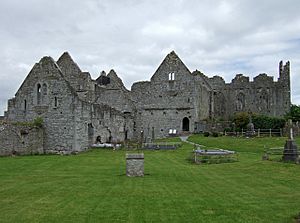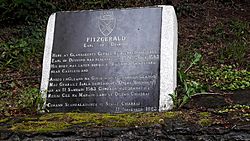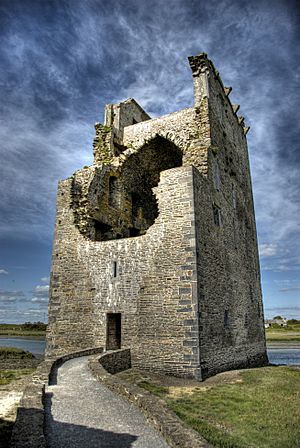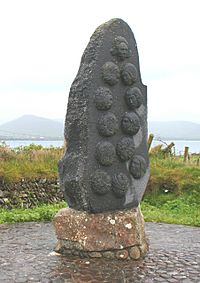Second Desmond Rebellion facts for kids
Quick facts for kids Second Desmond Rebellion |
|||||||
|---|---|---|---|---|---|---|---|
| Part of the Desmond Rebellions | |||||||
|
|||||||
| Belligerents | |||||||
| Commanders and leaders | |||||||
| In Munster: James FitzMaurice FitzGerald John FitzGerald James Fitzedmund Fitzgerald Gerald FitzGerald Nicholas Sanders In Leinster: Fiach Mac Aodh Ó Broin James Eustace, 3rd Viscount Baltinglass |
Arthur Grey John Perrot William Pelham William Stanley Thomas Butler |
||||||
| Strength | |||||||
| Unknown | Unknown | ||||||
| Casualties and losses | |||||||
| Unknown | Unknown | ||||||
The Second Desmond Rebellion (1579–1583) was a big and bloody conflict in Ireland. It was started by the FitzGerald family of Desmond in Munster. They were fighting against English rule.
This rebellion began in July 1579 when James FitzMaurice FitzGerald arrived in Ireland. He brought soldiers sent by the Pope. This sparked a revolt across southern Ireland. The Desmond family, their friends, and others unhappy with English rule joined in.
The rebellion was a protest by powerful Irish lords. They did not like the English government interfering in their lands. It was also a reaction to English policies that were harming traditional Gaelic culture. Plus, it was a religious fight. The rebel leaders saw themselves as defending Catholicism. They felt they were being treated unfairly by the Protestant Queen Elizabeth I. The Pope had even called her a tyrant and a heretic in 1570.
The rebellion ended in 1583 when Gerald FitzGerald, 14th Earl of Desmond died. The rebels were defeated. This led to the end of the Desmond family's power. Their lands were then given to English settlers in what was called the Munster Plantation. The fighting also ruined much of southern Ireland. Many people died from hunger and sickness caused by the war. It's thought that up to a third of Munster's population died.
Contents
Why the Rebellion Started
First Rebellion: 1569–1573
The FitzGerald family in Munster were known as the Geraldines. Their leader was the Earl of Desmond, Gerald FitzGerald, 14th Earl of Desmond.
The first Desmond Rebellion (1569–1573) was a protest against English control. The English were creating a new governor role in Munster. They also favored the Butler family, who were rivals of the FitzGeralds. English settlers were also moving onto Irish lands.
The Geraldines were especially upset because Earl Gerald and his brother John were arrested in 1568. This was because they had fought a private war against the Butlers. This war ended with the Battle of Affane in County Waterford.
The First Desmond Rebellion started in 1569. It was led by James FitzMaurice FitzGerald, the army's "captain general." The English forces, helped by Irish allies like the Butlers, stopped this rebellion. It ended in 1573.
After the First Rebellion
After the first rebellion, the English tried to make peace with the Geraldines. Fitzmaurice, the rebel leader, was forgiven. The Earl and his brother John were released from prison and got their lands back. In 1579, it seemed unlikely the FitzGeralds would fight the English again.
However, several things led to a new rebellion in July 1579. Fitzmaurice, who led the first rebellion, lost his land and power. English settlers took over his inherited lands. The Earl of Desmond was also stopped from keeping a large private army. This meant Fitzmaurice, a professional soldier, lost his income.
Fitzmaurice became poor. In 1574, the Earl even evicted him from land he was renting. On top of this, Fitzmaurice strongly believed in the Catholic faith. He disliked Protestantism, which the English had brought to Ireland. In 1575, Fitzmaurice left Ireland for France. He hoped to get help from Catholic countries to restart the rebellion.
The Second Rebellion Begins
The reasons Fitzmaurice rebelled also made many others in southern Ireland ready to fight. First, Irish soldiers who had lost their jobs from private armies faced poverty. After the first rebellion, English leaders had executed many unemployed soldiers. The remaining soldiers in Munster became the core of the new rebellion.
Second, many local Irish lords felt threatened by English land policies. The English would take land if the owner didn't have an English legal document for it. Then, they would set up English settlements. Third, the English put military governors, called seneschals, in areas where local leaders used to be independent. This meant some chiefs, like Fiach MacHugh O'Byrne in the Wicklow Mountains, were already fighting the English.
Finally, differences in culture and religion also caused anger. In the early 1570s, an English leader banned parts of traditional Irish culture. This included Brehon law, Irish poetry, and Irish clothing. Also, the English made Protestantism the official religion in Ireland. But most Irish people were Roman Catholic. This became a big test of loyalty to the English government. The Pope had even removed Queen Elizabeth from the Church in 1570. Fitzmaurice used these feelings to gain support. He spoke only Irish, wore Irish clothes, and fought for the Catholic faith.
Failed Invasion of 1578
While in Europe from 1575, Fitzmaurice tried to get support for a new rebellion. He talked to leaders in France and Spain about invading Ireland. But the Spanish King Philip II of Spain was busy fighting in the Dutch Revolt. He wasn't interested in helping.
Fitzmaurice had more luck with Pope Gregory XIII. He met English Catholic priests who wanted to invade England. They hoped to remove Queen Elizabeth and bring back a Catholic king or queen.
Fitzmaurice and an English adventurer named Captain Thomas Stukley planned an expedition. Their goal was to make the Pope's nephew, Giacomo Boncompagni, King of Ireland. English Catholics supported this idea.
The Pope gave Stukley 1000 soldiers in March 1578. They sailed from Italy. In Spain, Stukley added some Irishmen. King Philip II sent him to Portugal to get better ships and meet Fitzmaurice. But the King of Portugal invited Stukley to join an invasion of Morocco instead. Stukley was killed there in August 1578. This ended Fitzmaurice's first plan to invade Ireland.
1579 Invasion
Nicholas Sanders, Fitzmaurice, and others went back to Rome. They formed a new expedition with the Pope's approval. With a small group of Irish, Spanish, and Italian soldiers, they sailed for Ireland in June 1579. They landed at Dingle harbour in County Kerry on July 16.
On July 18, they anchored at Smerwick harbour. There, they set up a fort at Dún an Óir (Fort of Gold). Nicholas Sanders proudly displayed the Pope's flag. Fitzmaurice declared a holy war. He said the Pope had approved it. This was a very serious matter. It meant Catholic subjects of Queen Elizabeth I no longer had to obey her. The Pope had removed her from the Church in 1570. Fitzmaurice openly challenged the English Queen's right to rule Ireland. This meant the rebellion would likely not end with a peaceful agreement.
On July 25, two more ships arrived with 100 more Spanish soldiers.
The Rebellion Starts
Fitzmaurice's small force might have been quickly defeated. But on August 1, John of Desmond joined him. John Fitzedmund Fitzgerald was a soldier like Fitzmaurice. He had many followers among his family and unemployed soldiers in Munster. After John joined, many soldiers joined the rebellion. John and his brother, James Fitzedmund Fitzgerald, showed their support by killing two English officials in Tralee.
John of Desmond and Fitzmaurice now had over 3000 men. This included some European soldiers and thousands of Irish troops. However, getting more help from Europe became difficult. On July 29, just four days after the landing, Sir William Winter seized the invasion ships. This cut off their sea routes.
The Earl of Desmond was happy with the English peace deal after the first rebellion. He tried to stay out of Fitzmaurice's new rebellion. He tried to gather his family to stop it. But he could only get 60 men. This was very different from the thousands his brother John quickly gathered. It showed that most of the FitzGeralds supported the rebellion.
Some of the invasion force went to other parts of Ireland. A few went to Carrigafoyle Castle in northern County Kerry. This was the Earl of Desmond's home. An Italian engineer helped improve the castle's defenses.
Fitzmaurice himself went to Connacht to try and start a rebellion there. But he was killed on August 18. This happened in a small fight after his men stole horses. This left John of Desmond in charge of the rebellion.
The rebels now controlled southern Munster. The English did not have enough soldiers to take it back. The English Lord Deputy, Drury, marched 600 men to Limerick. There, he met Nicholas Malby with 1,100 English soldiers. Drury was sick and died soon after. Malby then took command of the English forces.
Earl Gerald Joins the Fight

In late October, Malby marched through the Desmond lands. He destroyed the countryside. He demanded that Earl Gerald surrender his castle at Askeaton. Desmond refused. He fought back when Malby tried to take the castle. William Pelham, the Lord Justice of Ireland, then declared Desmond a traitor. This meant Desmond was to be captured and executed. This forced Gerald and the remaining FitzGeralds to join the rebellion.
The Earl took over the rebellion in a dramatic way. On November 13, 1579, he and his followers attacked the town of Youghal. They killed the English soldiers there. They also hanged English officials, stole from the town, and treated the people badly. Desmond's forces then blocked the city of Cork. After that, they moved west into the Kerry mountains. Meanwhile, MacCarthy Mor, a chief of the MacCarthys, joined the rebellion by attacking Kinsale.
Spring 1580 Campaign
The English forces responded to Desmond's actions with equal force. Thomas Butler, 3rd Earl of Ormonde, Sir William Pelham, and Sir George Carew were sent to Munster. They aimed to defeat the rebels. They systematically destroyed the Desmond lands in County Limerick, County Cork, and north County Kerry. They also killed civilians. These tactics were meant to hurt the Desmonds' followers so much that they would stop fighting.
The English forces included not only English soldiers but also Irish groups who disliked the Geraldines. These included Ormonde's followers and over 1000 fighters from the MacCarthy Reaghs. The O'Driscolls also helped. Hugh O'Neill, 3rd Earl of Tyrone, also led soldiers from his lands in Ulster.
In March 1580, the English forces won an important victory. They captured the Desmond stronghold at Carrigafoyle Castle. This castle was at the mouth of the River Shannon. With 1400 soldiers and help from naval forces, William Pelham captured Carrigafoyle. They killed the rebel soldiers there. This cut off the Geraldine forces from the north. It also stopped foreign troops from landing in the main Munster port of Limerick.
When news of Carrigafoyle's fall spread, other Desmond strongholds quickly gave up. The castle at Askeaton was abandoned. Its Spanish defenders blew up the walls. Garrisons at Newcastle West, Balliloghan, Rathkeale, and Ballyduff surrendered soon after. Many lords who had joined the rebellion also surrendered. They believed the English were winning. Those who surrendered included MacCarthy Mor, Roche, Barry, and others.
It seemed the rebellion was defeated by the summer of 1580. But it was revived by a new rebellion in the eastern province of Leinster.
Rebellion in Leinster
In July 1580, Fiach McHugh O'Byrne started a rebellion in eastern Ireland. He was based in the Wicklow Mountains. He brought together local lords and clan leaders. These included the Kavanaghs, O'Tooles, and O'Moores. Many of them had already been fighting the English for years. Unfair killings by an English officer seemed to make many people revolt.
To show they rejected English rule, the rebels made Creon MacMurrough Kavanagh King of Leinster. His ancestors had held this title before the English conquest. O'Byrne was joined by James Eustace, 3rd Viscount Baltinglass. He was an Old English lord from the Pale. He joined mainly because of his strong Catholic faith.
In August, John of Desmond and Nicholas Sanders met Baltinglass in Laois. They tried to plan their attacks together. But they could not agree on a common strategy. Still, a rebellion so close to the English government in Dublin worried the English greatly.
Sir Henry Sidney, a former English leader, influenced the response. In August 1580, a new Lord Deputy, Arthur Grey, 14th Baron Grey de Wilton, was sent from England. He brought 6000 soldiers. Grey's first goal was to stop the Leinster rebellion.
On August 25, 1580, English forces under Grey were defeated in the Battle of Glenmalure. They were fighting O'Byrne and Viscount Baltinglass's forces. While trying to attack O'Byrne's fort in the Wicklow mountains, they were ambushed. They lost over 800 men. William Stanley was sent to defend the Pale area of Leinster. For the rest of the war, O'Byrne and his allies attacked English settlements. But they could not use their victory at Glenmalure to gain more land.
After the rebellion, many people from the Pale and other areas like Wexford were executed. These areas had always been loyal to English rule before. Those executed included Dermot O'Hurley, the Catholic Archbishop of Cashel. Margaret Ball, the wife of the Lord Mayor of Dublin, also died in prison. Those executed often declared their Catholic faith. Their Church honored them as Catholic martyrs. These executions made many of the Old English people turn away from the English state in Ireland.
1580 Spanish and Papal Landing
On September 10, 1580, Spanish ships landed a force of 600 Spanish and Italian soldiers. They were led by Sebastiano di San Giuseppe. They landed at Smerwick, near where Fitzmaurice had landed the year before. They brought weapons for thousands of men. King Philip II of Spain sent these, and Pope Gregory paid for them.
Desmond, Baltinglass, and John of Desmond tried to meet up with these new soldiers. But English forces blocked them. English ships also trapped the Papal force's ships in Smerwick bay. San Giuseppe had no choice but to fortify his men in the fort at Dún an Óir.
In October 1580, Grey de Wilton arrived at Smerwick with about 4000 soldiers. He began to attack the fort. The invading forces were stuck on the narrow Dingle Peninsula. They were cut off by mountains on one side and the much larger English force on the other. They had no way to escape. The English also brought heavy cannons by sea. These quickly broke down the fort's defenses.
After three days, Colonel Di san Giuseppe surrendered on October 10, 1580. He agreed to take a bribe. The English entered the fort. Grey de Wilton ordered the soldiers to be killed. The Italian and Spanish soldiers were executed.
The writer and explorer Walter Raleigh was among the English soldiers there. This event was later used against him in a trial. Raleigh argued he had to obey his commander. But he could not clear his name.
End of the Rebellion
After the events at Smerwick, the rebels were clearly losing. However, the war continued for two more years. The fighting became very harsh. Civilians suffered greatly. Both sides targeted them, destroying their crops, animals, and homes.
Grey, the English commander, said his tactics were "burning their corn, spoiling their harvest and driving their cattle." This caused hunger and diseases. In the summer of 1582, Queen Elizabeth I removed Grey from his position. She felt he was too brutal. By mid-1582, it was reported that about 30,000 people had died from hunger in Munster alone. Hundreds were dying in Cork city from starvation and disease.
Meanwhile, the rebellion slowly fell apart. After the defeat at Smerwick, the Pope stopped helping Nicholas Sanders. Sanders spent almost two years hiding in southwest Ireland. He is believed to have died from cold and hunger in spring 1581. In April 1581, a general pardon was offered to everyone except the rebellion's leaders. Many of the Earl of Desmond's supporters surrendered.
Baltinglass fled to France in August 1581. Fiach MacHugh O'Byrne pretended to surrender in April 1581. But he continued his attacks after a short time. He finally surrendered in September 1582. This ended the fighting in Leinster.
There was no pardon for the Earl of Desmond. English forces chased him until the end. For the rest of the war, the Earl and the remaining Geraldines hid in the mountains of Kerry and Tipperary. They fought a guerrilla war. In early 1582, John of Desmond was killed in a small fight north of Cork.
The rebellion finally ended in 1583. The Earl of Ormonde took command of the English forces. Ormonde used a less harsh approach than previous officers. He preferred talking to destroying everything. He kept the rebels in west Cork and Kerry. He also convinced many of Desmond's close relatives to surrender.
On November 11, 1583, the Earl was killed in Glenaginty. This was near Tralee in County Kerry. He was killed by the local Moriarty clan. The Earl and his followers had raided the Moriarty clan's property. They stole cattle and treated the clan chief's sister badly. Men from the Moriarty clan chased the Earl's followers. They caught and killed the Earl. Owen Moriarty, the clan chief, received 1000 pounds of silver from the English government for Desmond's head. It was sent to Queen Elizabeth in London. The Earl's body was proudly displayed on the walls of Cork city.
What Happened Next

Munster continued to suffer from sickness and hunger after the rebellion. It was described as having large empty areas and far fewer people. Perhaps as many as one-third of the province's population died in the war.
The main result of the rebellion was the end of the Desmond family's power in southern Ireland. Their lands, and those of their allies, were taken by the English. After a survey in 1584, these lands were given to English settlers. This was called the Munster Plantation. The title of Earl of Desmond was later brought back. During another rebellion, the Nine Years War in the 1590s, the English tried to introduce a new Protestant Geraldine Earl. He had grown up in England, but it did not work.
In Leinster, Fiach MacHugh O'Byrne surrendered. But he was later killed leading a new rebellion in the Nine Years War. James Eustace, 3rd Viscount of Baltinglass, went into exile. He died in Spain in 1585. His title and property were taken by the English.
Many other former rebels were pardoned. But they lost some land and had to pay large fines.
The destruction of so many important Irish families and the settlement of their lands by English people made the Second Desmond Rebellion a key event. It was part of the Tudor conquest of Ireland. This was a century-long process that saw all of Ireland come under English control by 1603. The killing of many Irish mercenary soldiers was also important. It helped the English government gain full control over military force in Ireland.
The rebellion also brought religious conflict into Irish history for the first time. The division between Irish Catholic landowners and Protestant English settlers and government would shape Irish life for another century. Its effects can still be seen today.
Notable People in the Rebellion
- James Fitzmaurice FitzGerald: Cousin of the Earl of Desmond, who organized the rebellions.
- Gerald FitzGerald, 14th Earl of Desmond: The main leader of the Desmond family.
- Pope Gregory XIII: Provided money and soldiers for the rebellion.
- Captain Thomas Stukley: English adventurer, leader of the first planned invasion force.
- Giacomo Boncompagni: The Pope's nephew, suggested as King of Ireland.
- William Allen: English priest in Rome who supported the rebellion.
- Nicholas Sanders: English priest and Papal representative with the invasion force.
- Sebastiano di San Giuseppe of Bologna: Commander of the invasion soldiers at Dún an Óir.
- Philip II of Spain: Provided soldiers for the rebellion.
- Matthew de Oviedo: Traveled with Fitzmaurice on the second invasion.
- John of Desmond: Brother of the Earl of Desmond, who became a leader of the rebellion.
- James Fitzedmund FitzGerald: A leader of the rebellion.
- Juan Martinez de Recalde: Spanish member of the invasion force.
- Fiach MacHugh O'Byrne: Irish chief who rebelled in Leinster.
- James Eustace, 3rd Viscount Baltinglass: A lord from the Pale who joined the rebellion in Leinster.
- Creon MacMurrough Kavanagh: Named King of Leinster by the rebels.
English and Their Allies
- Elizabeth I of England: Queen of England.
- Owen Moriarty: Chief of the Moriarty clan, who killed the Earl of Desmond in 1583.
- Sir Henry Sidney: Former English leader in Ireland.
- Sir William Winter: English naval commander.
- Sir William Pelham: English army commander.
- Sir George Carew: English army commander.
- Arthur Grey, 14th Baron Grey de Wilton: English leader in Ireland.
- William Stanley: Army commander.
- Richard Bingham: Member of the English army.
- Sir Walter Raleigh: Member of the English army.
- Edmund Spenser: Member of the English army.
- Thomas Butler, 3rd Earl of Ormonde: Supported the English forces.
- Hugh O'Neill, 3rd Earl of Tyrone: Supported the English forces.
- Owen MacCarthy Reagh: Supported the English forces.
See also
- List of Irish rebellions
- Rising of the North
- Other events of the Tudor conquest of Ireland
- Nine Years War (1594–1603)
- Other Spanish invasions of Ireland
- Spanish Armada in Ireland (1588)
- Battle of Kinsale (1601)




